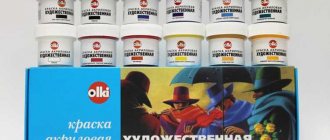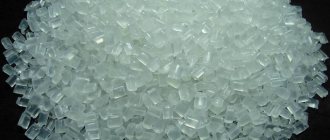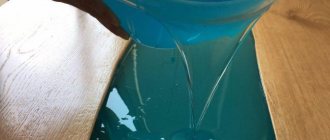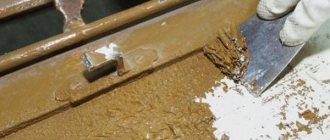Painting on fabric with acrylic paints allows you to create unique and exclusive items from ordinary everyday wardrobe items. The creative process of drawing on fabric is so interesting and exciting that it can turn from an ordinary hobby into a real business idea for creating additional income. Painting with acrylic paints is easy and fun. Our article and the presented master classes will help you understand in detail all the intricacies of painting with acrylic paints.
Beginners often think: “What happens if I paint something wrong, can it be fixed if I use acrylic paints and use certain fabrics?” But there's no need to worry. Errors can be corrected.
Acrylic paints for painting on fabric
The best paints for painting on fabric and clothing are acrylic dyes, which are based on polymers. This means that the coloring pigment does not penetrate into the fibers, but, as it were, covers them with a protective film. The structure becomes denser and loses its elasticity.
Products coated with fabric paints become colorful, bright and unique. In addition, the acrylic coating gives the painting a waterproof effect.
Painting fabric with acrylic paints: pros and cons
Acrylic is the best polymer dye for clothing. When painting, pigments do not seep into the fibers, but remain on the surface, forming a film. The painted surface of the fabric becomes denser and becomes less elastic. Acrylic paint allows you to create bright, multi-colored, water-resistant images on clothing. The palette is rich, colors can be mixed to create additional shades.
Acrylic fabric paints are subject to high safety requirements. They are made from environmentally friendly components that are odorless and do not cause an allergic reaction.
Acrylic is an ideal option for beginning craftswomen.
Advantages and disadvantages
environmental safety, harmlessness to health;
safe components in the composition - pigments, water, natural or synthetic resins, plasticizers;
ease of use;
easy-to-apply texture;
quick drying with the formation of a protective surface film;
Possibility of diluting with water, mixing paints to obtain many shades;
waterproof coating that can withstand repeated washings;
wide range, constant availability in stores.
over time, acrylic loses its quality characteristics, so the paint will have to be thrown away after the expiration date;
The fabric requires the application of enclosing contours, since water-based paint is fluid.
Advantages of acrylic paints
Acrylic paints for clothing are the most popular type of dyes among home painters and professional artists. The advantages and disadvantages of acrylic paints for painting on fabrics include:
- wide range and availability for sale;
- safe and easy to use;
- possibility of adding water as a diluent;
- water resistance of the coating of the patterns and the ability to withstand washing of products;
- acrylic paints for multi-colored painting on fabric are easily mixed, which makes it possible to obtain various new shades.
To fix acrylic painting, dry it using a slightly heated iron.
The disadvantages of acrylic paints for painting include:
- deterioration of the coloring properties of pigments during long-term storage;
- mandatory use of additional contours due to the increased fluidity of acrylic pigments.
With paints for painting on fabric, you can not only paint wardrobe items, but also decorate textile shoes, paint a handbag or apply a permanent design on an umbrella. The painted surface is very pleasant to show to others, and hand-dyed fabrics are sometimes better than clothes from fashion houses. You just need to draw on clothes carefully.
How to create rich paint for indoor wall painting?
- The most important thing is to buy pigments. For example, COLOREX (SNIEZKA) or Pigment MIX. The advantages and disadvantages of these pigments are approximately equal: Although SNIEZKA has a richer color palette, it also has a sharp, specific smell.
- Buy white paint, preferably zinc white. It is less desirable to use 80% titanium dioxide acrylic paint as the white.
- Mixing pigment and paint. It is convenient to do this with cotton swabs. Buy plastic containers of the required volume in advance: small, medium or large.
- Adjust the amount of pigment.
- You can add mother-of-pearl to the resulting paint to obtain beautiful gold, ash, silver and red shades.
- To create mother-of-pearl, instead of a white base, add silver acrylic decorative metallic.
Tips and subtleties of the masters:
- To get a beautiful color, you can mix two bases: metallic silver and white paint.
- Silver paint can be added to regular paint to increase adhesion (adhesion of paint to the surface of the base) and reduce cracking.
- The tone of the pearl depends on whether you heavily dilute the paint with water or not.
As they say, everyone is a cooper, but only a few are thanked. Do-it-yourself acrylic painting of walls is a responsible undertaking, and you can buy ready-made acrylic paints so as not to worry about the result. new acrylic paints have become available for widespread use:
:
- fluorescent - glow when illuminated by ultraviolet lamps;
- invisible paints (a subtype of fluorescent) - they are invisible in daylight, but are able to “come to life” in the dark;
- luminescent paints, or luminous ones - they are able to accumulate light during the day, and in the dark. accordingly, it is given away;
- mother-of-pearl, with sparkles (basic colors: pearl, silver and gold). Gives the effect of iridescence, iridescent color radiance in bright lighting;
- metallic, one-component composition with aluminum powder (silver). It can be gray, black, red, green, but has a characteristic metallic sheen.
- for swimming pools and bathrooms (moisture-resistant acrylic).
Choosing the right fabric for painting
If you give advice on choosing paint for fabric for beginners, then you should immediately note that there are no restrictions on the material for painting with acrylic. You can paint any materials: thick textiles, popular denim, delicate silk, thick cotton or linen. When choosing, you should not forget that the areas painted with acrylic paint will have a dense structure.
Typically, manufacturers of acrylic paints for fabric indicate the recommended type of fabric on the stickers of tubes and jars:
- If the label contains the inscription “Silk,” this means the pigment is intended for dyeing soft and thin fabrics, such as silk, cambric, and chiffon.
- The designation “Textile” means that this type of acrylic fabric paint is recommended for painting dense materials, natural leather, velvet, and suede. Dyeing the fabric will be easy. It is enough to use the necessary means.
Thick fabrics can be painted well with acrylic using a template or stencil. In this case, the design will have clear boundaries with a pronounced color print. Anyone can learn how to paint clothes with acrylic paints. To do this, it is not necessary to have special artistic training.
In craft stores and art stores you can find ready-made stencils and templates with floral designs, animal figures, geometric prints and many other images.
Preparatory work
Before painting with acrylic paints on fabric, it is recommended to carefully prepare the selected base: immerse it in cold water for an hour and wash it a little. After rinsing in clean water, it is best to dry the fabric and then iron it with a warm iron.
If the material is thin, such as cambric or silk, then it is better to stretch it on a wooden frame and leave it to dry completely. If you decide to decorate a piece of clothing, it is best to isolate one layer from the other using cardboard or thick paper.
On video: how to paint fabric with acrylic paints.
Finishing, wall priming
Primer
– this is strengthening the surface of the walls for further finishing
- The first application penetrates the surface and fills cracks and large crevices.
- Formation of a thin film on the wall using priming.
- After applying each new layer of putty, prime with special compounds, a strengthening primer.
Materials: type of primer required for work, depending on the type of wall:
- anti-corrosion primers;
- insulating primers;
- water-repellent primers;
- strengthening primers;
The primer is selected depending on the goals set before carrying out construction or repair work.
[my_custom_ad_shortcode5]
Types of acrylic painting
Hand-painted fabric using reserve compounds is called batik. This definition of painting can be found on Wikipedia. Batik technology involves applying appropriate paint to a selected fabric base. To obtain clear boundaries at the junction of coloring compounds, a special fixative is used, called a reserve compound.
Acrylic dyes can be used in several types of painting:
- Hot batik with melted wax or paraffin. With it, after dyeing the fabric and removing the wax coating, a white or multi-colored pattern is obtained on a colored background. This application technique has long been popular, but it requires special skills.
- Cold batik using contours of reserve compounds. The contours create clearly defined boundaries and prevent the acrylic dye from bleeding onto the fabric. The drawing is obtained with a bright graphic look. With cold batik, it is possible to use ready-made templates or stencils as an outline.
- Knotted batik dyeing involves forming a pattern outline with small knots. Knots can be tied directly on the fabric, or you can use strong threads or cord for this purpose. After dyeing the fabric, the knots are unraveled and new ones are made. This continues until the end of the pattern. Gradual smooth transitions from light to dark colors create a picturesque and interesting pattern.
- Free painting is similar in its process to painting in watercolors. It is applied directly to the fabric and allows you to freely embody any creative idea or design. At the final stage, reserve compounds are used to ensure clarity of shades. This type of painting is more suitable for people with artistic skills.
- Painting using an airbrush. It allows you to spray the smallest particles of acrylic paint. The airbrush works as an improved spray gun; it is convenient to spray paint at a distance of 20-30 cm from the surface of the fabric.
Even the simplest type of acrylic painting can significantly transform everyday, familiar items of clothing or interior design.
Subtleties of painting technique
When applying acrylic paints, it is important to consider some rules:
- Diluted acrylic paint will color the fabric worse, and to prevent the coating from being washed off when washing the product, it is recommended to use branded real thinners.
- The dyeing surface of a fabric or item of clothing is separated from the working surface of a table or other object with an impermeable spacer film or wax paper.
- To understand how to paint fabric using a stencil or template, you can imagine an ordinary children's coloring book. The only difference is that when applying acrylic layer by layer, you need to wait until the previous layer has completely dried.
- First, a light tone is applied to the drawing, and then smoothly transition to darker tones.
If you paint on fabric according to these simple rules, you can get an acrylic coating that will not wash off even after repeated washings. Sometimes it’s enough to watch a master class and everything will become clear.
How to care for a painted product
Once the item has been painted and dried, it is followed by proper care, thanks to which the paint will last a long time and remain bright.
- The product should only be washed at a temperature not exceeding 40 degrees.
- The amount of powder should be minimal; the product is used without bleach.
- When washing by hand: do not twist the fabric or rub in the area where the pattern is located.
- Before washing, the product is turned inside out, and then straightened out and hung on a clothesline.
- The item cannot be soaked.
- Iron carefully, from the inside out.
You might be interested in: Ways to narrow and sew jeans on your own at home
If you follow the recommendations, acrylic painting on fabric will last a very long time.
Methods of applying acrylic paints
There are several ways to draw on fabric or clothing. The method of painting with paints depends on the tool used, on what paints the drawing will be applied with:
- Drawing with a brush.
- Screen or template printing using special rollers or various foam pads.
- Creation of an acrylic relief contour in combination with painting with brushes.
You can easily learn how to draw amazing and unique beauty using acrylic painting. From ancient times to the present day, the beauty of this fascinating creative process is finding more and more fans. If you try to create such a handmade miracle yourself, then it will be impossible to stop, the process of creating masterpieces of painting with your own hands is so addictive and captivating.











